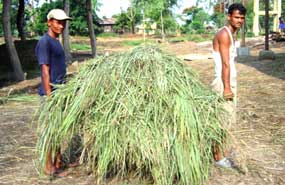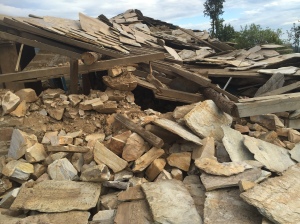 Kailash Dixit is a chemical engineer and a distiller. After 15 years as an alcohol distiller, Kailash took some time off to explore his country, Nepal and its biodiversity. He realized that the work he was doing was contributing unhealthy products to the poor people in Nepal. This changed his mind about his work and how he was contributing to society. In his words, “As a result of this sadness, I wanted to make the most out of Nepal’s natural resources that the world could benefit from. I wanted to work in an environment that is peaceful, invigorating and full of camaraderie. I quit my job because I wanted do something more rewarding to the country, to the people and to myself using my skills in distillation and my background as a chemical engineer. I established an essential oil manufacturing distillery in 2004. I fell in love with the work that I am doing today. I realized my passion and my passion became my business. I am a proud essential oil manufacturer and a distributor from Nepal.”
Kailash Dixit is a chemical engineer and a distiller. After 15 years as an alcohol distiller, Kailash took some time off to explore his country, Nepal and its biodiversity. He realized that the work he was doing was contributing unhealthy products to the poor people in Nepal. This changed his mind about his work and how he was contributing to society. In his words, “As a result of this sadness, I wanted to make the most out of Nepal’s natural resources that the world could benefit from. I wanted to work in an environment that is peaceful, invigorating and full of camaraderie. I quit my job because I wanted do something more rewarding to the country, to the people and to myself using my skills in distillation and my background as a chemical engineer. I established an essential oil manufacturing distillery in 2004. I fell in love with the work that I am doing today. I realized my passion and my passion became my business. I am a proud essential oil manufacturer and a distributor from Nepal.”
Establishing a cooperative to support the community In 2004, he founded Aarya Aroma with three major objectives: 1) to cultivate essential oil-bearing plants, 2) to process essential oils, and 3) to provide the marketing and sales of essential oils on the international market. He leased more land (divided between 19 farmers) and installed more distillation units. This became the birth of a cooperative. “We also initiated collection of wild harvested herbs for distillation in partnership with the community forest user groups. We ensured buy-back guarantee of the raw material and the essential oils produced by the cooperative, locally owned enterprise and community forest user groups.”
The work of the cooperative supports the local community and helps the international community by providing the pure essential oils. Nepal has approximately 700 species of Medicinal and Aromatic Plants (MAPs) and 80% of the population depends on agriculture.
Devastating earthquakes On April 25 and May 26, 2015 massive earthquakes hit Nepal and took more than 10, 000 l ives and internally displaced more than six million people. Kailash, once again motivated to help his people, went to the mountains to help the earthquake victims. With some financial funding, he visited the Wintergreen harvesting/collection area (2400-2800m) and stayed in the remote village for five days distributing some relief goods. He witnessed the destruction of 100% of the houses there. Aarya Aroma are currently in the planning phase to help the herb farmers/collectors in the remote mountains to re-build and relocate. Relocation is a bit tricky, as the mountain soil has been loosened and when the Monsoon (rainy) season begins, huge landslides are predicted.
ives and internally displaced more than six million people. Kailash, once again motivated to help his people, went to the mountains to help the earthquake victims. With some financial funding, he visited the Wintergreen harvesting/collection area (2400-2800m) and stayed in the remote village for five days distributing some relief goods. He witnessed the destruction of 100% of the houses there. Aarya Aroma are currently in the planning phase to help the herb farmers/collectors in the remote mountains to re-build and relocate. Relocation is a bit tricky, as the mountain soil has been loosened and when the Monsoon (rainy) season begins, huge landslides are predicted.
A 10-point plan to relocate and rebuild a sustainable community Aarya Aroma has devised a  development and implementation strategy to help these people who grow and harvest Wintergreen. They have already purchased land from previous private donations from friends in the aromatic/herb community, but there is much more to be done.
development and implementation strategy to help these people who grow and harvest Wintergreen. They have already purchased land from previous private donations from friends in the aromatic/herb community, but there is much more to be done.
1. In the area where Wintergreen is grown and harvested, 25% people are well off and have already taken initiative to rebuild their homes on their own expense. They aim to help the poorest of the poor who live on their daily wages (less than $5.00/day USD).
2.With the help of the international community, they plan to rebuild community homes (approximately 500-600 square feet), mostly using the debris. We will be using the same stones that got crumbled from the same house, carefully paying much attention to the structural safety. We will also be using the same windows and doors. They estimate is 50% of windows and doors need to be replaced.
3. They are not trying to rebuild fancy homes, the structure and their way of living will be very similar, but somewhat improvised. The estimated cost for each house is $6000 USD. It is very hard for the villagers to accept the sudden move from where their families have been living for centuries in harmony with their neighbors, so the people will only be relocated within a 1-1.5 km radius (approximately a walking distance of 10-15 minutes to reach their farm).
4. They aim to make the model community housing as sustainable as possible using their natural resources. An example is to construct micro-hydro power plant, costing $4000-$5000 USD and would provide lights for 15-20 homes.
5. They plan to build a community bio gas plant using human feces and urine; if inadequate they could also use cattle dung. This can provide an alternative source of cooking fuel six months without having to chop down trees for firewood.
6. People in this locality literally do not take shower because of the cold. For health reasons they will build a common bathing place for the families. The water will be heated using solar energy (one for males and another for females-separated by a common wall).
7. There will be a playground for children. In mountains there is no playground for kids.
8. Work has already begun on the model community housing and shared with one of the best advertising companies of Nepal. They are creating a 5 minute presentation to share about the project and the need for funding.
9. Their plan is to support the people 80% financially. The families will pay the remaining 20%, so as not to take things for granted and to have some pride in responsibility and ownership.
10. To appeal to the donor community.
Concerns regarding donations There is concern that any donations will be delayed in reaching the areas that need it and the government may be incapable of spending the money appropriately. There is not yet a local government. Aarya Aroma aims to do this work as good citizens and provide a model for the to emulate. Likewise the donor community needs to be equally transparent on how they spend the money while being most economical in whatever endeavor we take so that the money will reach to the neediest families.
On a personal note I’ve met Kailash personally. He is a warm and wonderful human being who greats everyone with open arms. He is humble, modest and without ego in his endeavors. His work with Aarya Aroma started and continues to be in service to the local community. By providing work to these areas of Nepal, Aarya Aroma stimulates the local economy as well as the international community. In a time when so many oils are adulterated to meet the demands of the larger cosmetic and perfume corporations, Aarya Aroma is dedicated to providing pure essential oils to the practitioner.
A gift for them, a gift for you! The International Journal of Professional Holistic Aromatherapy, International Journal of Clinical Aromatherapy, the Aromahead Institute, and the Institute of Traditional Herbal Medicine and Aromatherapy. A private donation site is currently being set up for you to donate. Please contact the IJPHA if you wish to donate to support the efforts of Kailash and Aarya Aroma in helping the people in this community in Nepal.
As a thank you for your donation, you will receive a free audio file of Kailash Dixit’s presentation from the Botanica2014 conference in Dublin, Ireland from Rhiannon Lewis.
Mollie Jensen has set up a Crowdrise account to collect donations.
https://www.crowdrise.com/rebuildavillageinnepal/fundraiser/molliejensen

